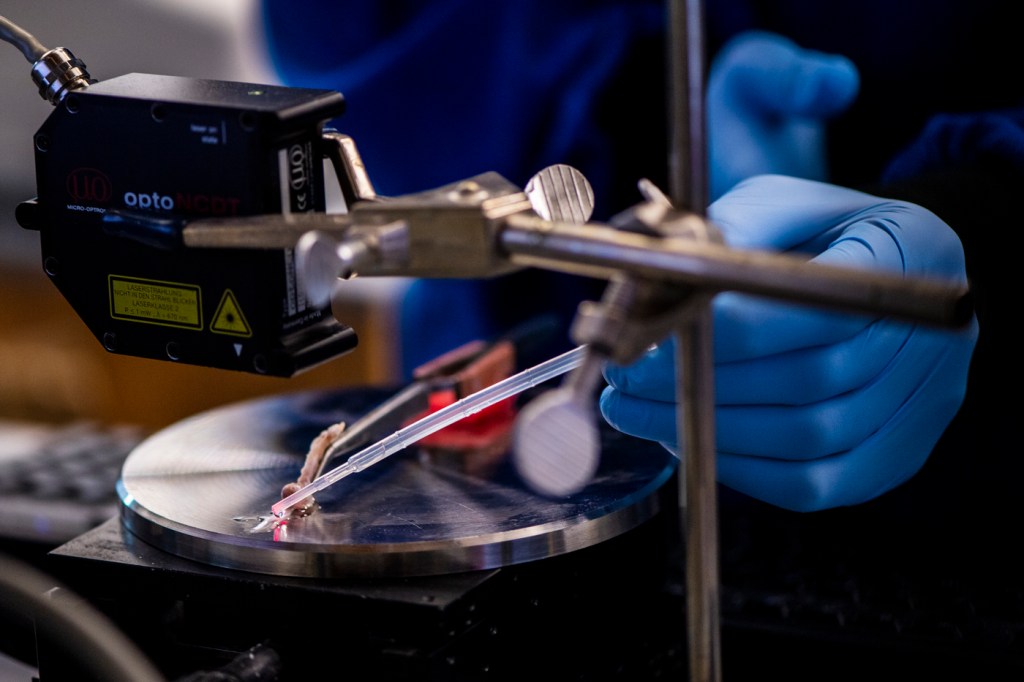How collagen could help heal your torn rotator cuff, Achilles tendon, meniscus and more

A Northeastern University spinout company focused on the therapeutic potential of collagen has attracted national recognition, finishing in the “final four” of a U.S. government competition that sought the next concept to transform health.
“We just navigated through all the best tech companies in the country,” said Jeffrey W. Ruberti, CEO of BrilliantStrings Therapeutics and a professor in the department of engineering at Northeastern.
BrilliantStrings Therapeutics was born out of Ruberti’s Northeastern lab, where he has been studying collagen—the most abundant protein in the body and the building block of connective tissues such as tendons, ligaments, muscle and skin and cartilage—since 2004. Over the years, Ruberti and his students have discovered that collagen is more than just an ordinary protein.
In fact, it’s a “brilliant string,” according to Ruberti. He outlined several major reasons for the protein’s brilliance.
First of all, it becomes resistant under force.
“If I take a bucket of collagen and stretch it, then the collagen forms fibers to resist the stretching,” Ruberti explained.
He contrasted this with a piece of string.
“If you take a piece of string and pull it tight, it’s easy to cut because it just snaps,” Ruberti said. “With collagen, you stretch it and it makes it harder to cut.”
Secondly, collagen seeks out injuries in connective tissues and forms fibers to repair them.
“It’s a material that tries to fix itself,” Ruberti said.
Finally, it is “clean,” according to Ruberti, meaning that if collagen is present someplace it is not necessarily needed, it just breaks down and falls apart.
“The collagen makes the strings in your body and knows what to do,” Ruberti said. “It goes to where you need it, and it doesn’t go anywhere else … You can dump it in and it will fix damaged material, and if it doesn’t, it will disappear.”
BrilliantString Therapeutics capitalizes on these properties of collagen to propose its use in healing injuries to connective tissue—either by injecting collagen directly into the site of the injury or, for larger tears, using a patch that releases the protein. It could thus be used as an early intervention for injuries that may not rise to the level of surgery, preventing further degeneration and pain, and enabling a “full recovery; half the time,” according to the company.
The company sees a roughly $30 billion worldwide market for the technology, and is anticipating its application first for rotator cuff injuries (which lead to 4.5 million doctor’s appointments and 415,000 surgical procedures per year in the United States, according to the company). It could eventually be used to heal injuries such as tears in the meniscus, Achilles tendon, ligaments and more.
There’s a long way to go before a collagen patch can heal your torn rotator cuff, however. The treatment has shown promise in healing animals with rotator cuff tears, and the company is raising money for further development.
But BrilliantStrings Therapeutics has caught national attention.
The ARPA-H-Dash to Accelerate Health Outcomes was launched on March 15 to help identify revolutionary, evidence-based ideas to transform health. It was a collaborative, online competition “open to bold thinkers across health, scientific and technology communities, as well as the general public,” where high-risk but high-potential “transformations” competed for a $15,000 grand prize.
President Biden proposed the creation of ARPA-H to improve the U.S. government’s ability to speed biomedical and health solutions. The competition, which used a bracket system similar to NCAA March Madness, ended Tuesday.
BrilliantStrings Therapeutics was one of the hundreds of entrants. It made it to the “final four” round.
“This is a national competition, and we made it through the NCAA-style March madness brackets and we ran up against a brutal competitor,” Ruberti said. “It’s pretty cool.”
Cyrus Moulton is a Northeastern Global News reporter. Email him at c.moulton@northeastern.edu. Follow him on Twitter@MoultonCyrus.






